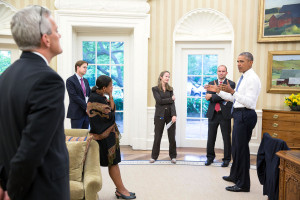Ferenc Dalnoki-Veress
July 2015
The following is an excerpt from an article originally published by the Homeland Defense & Security Information Analysis Center (HDIAC).
The deal struck between the P5 +1 (5 permanent members of the UN and Germany) and Iran satisfies two major objectives. First, it limits the possibility of diverting a peaceful nuclear energy program for nuclear weapon production; and it enables the means to detect cheating by Iran with reasonable certainty. The emphasis on reasonable certainty is deliberate, it is not reasonable to expect a verification regime to be perfect, and detect a diversion with 100 percent certainty. A compromise is always made in what is possible, reasonable and affordable.

President Barack Obama talks with national security staff after being notified of the nuclear agreement with Iran. (Official White House Photo by Pete Souza).
It is also important to remember the grand bargain made under the treaty of the nonproliferation of nuclear weapons (NPT) between states that possessed nuclear weapons at the time the treaty went into force […] Unfortunately, the NPT was not completely clear about what is and what is not legal, and the problem is compounded by the fact that a peaceful and a military nuclear program intersect at various points in what is called the nuclear fuel cycle. […]
Iran has constructed several elaborate centrifuge enrichment facilities in order to produce fuel for its reactors. The problem is that exactly the same facility can also be used for nuclear weapon production. The current treaty essentially closes such cheating scenarios by first cutting Iran’s uranium enrichment capability by two-thirds and then dramatically slashing its current stockpile of low enriched uranium, increasing the time required to produce enough enriched uranium for a bomb from 2-3 months to upwards of a year. Other measures as part of the deal are limiting research, development and testing of more advanced centrifuges, and having continuous surveillance at their points of production. All of these steps are time-bound with some steps lasting 10 years but others such as continuous access to uranium mines lasting as long as 25 years.
Continue reading at HDIAC.org:
Understanding the Fuel Cycle in the Iran Agreement
